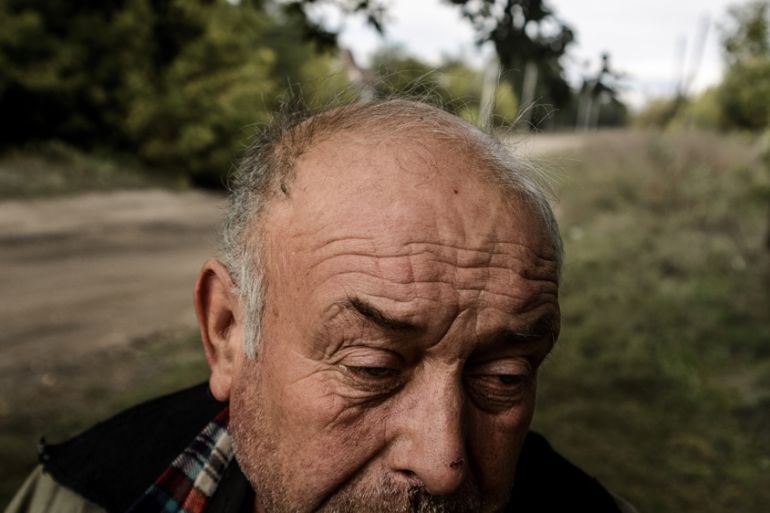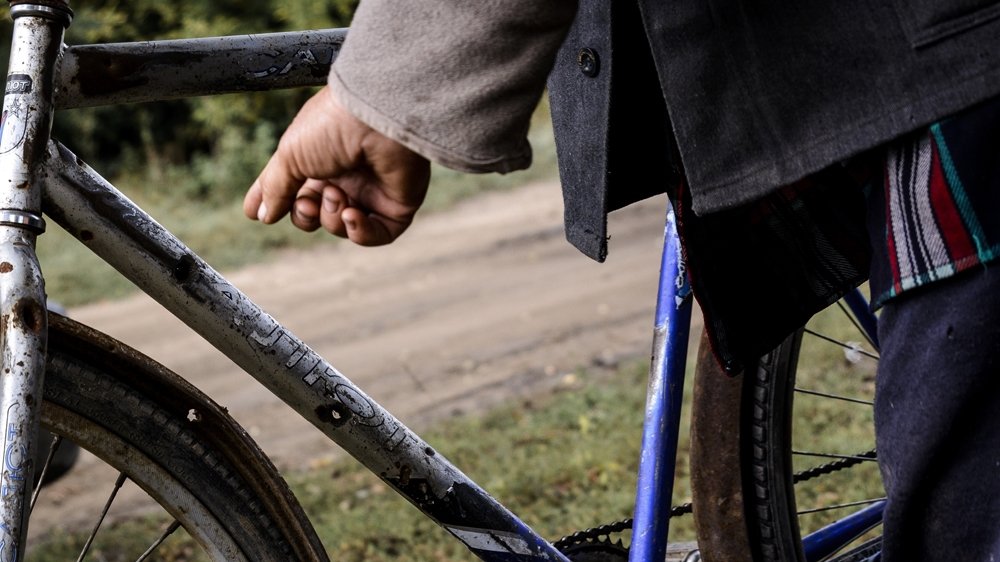Ukraine: The lasting impact of landmines on civilians
No one knows how many civilians have been killed by landmines or how many have been planted and where.

Lisichansk, Ukraine – What Konstantine Zarubin and his childhood friend Edek didn’t realise that summer evening two years ago, was that the quarry in their hometown they were about to climb through had just been littered with landmines.
It was a July evening in 2014, just months into an ongoing conflict between Moscow-backed rebels in country’s east and the fledgling post-Maidan government in Kyiv. The boys could hear fighting from their Soviet-era apartment building and were curious to get a closer look.
“We were over halfway over the quarry,” 14-year-old Konstantine remembers, describing how his friend was a metre, maybe two ahead of him, “when we heard a ‘pop’.” He didn’t hear the explosion, he said, but he felt its impact and watched as a wave of gravel and earth descended upon him.
Although the fighting in Lisichansk is over, the scars of war are still visible on the bullet-pocked buildings on the city’s outskirts.
Beyond the lace curtains of Konstantine’s sitting room, it’s a grey autumnal day. The quarry where Edek died is visible through a light fog. Konstantine’s grandmother, sitting in an armchair on the other side of the living room, tears up as he recounts what happened that evening.
When, seconds after the explosion, the boy picked himself up and shook the earth from his clothes, he was in a state of shock. Then he noticed the blood splattered on his legs and shoulders.
Konstantine is not the only young man to lose a friend to explosive remnants of war (ERW) in a conflict that has claimed 10,000 lives.
No one knows exactly how many civilians or fighters have been injured or killed by landmines, booby traps, or unexploded ordnance.
|
|
This is partly because there isn’t yet any central authority responsible for keeping track. Plans are under way, however, to establish a national mine-action authority.
Among the estimates based on publicly available reports, Marcus Brand, the democratic governance adviser for the United Nations Development Programme in Ukraine, told Al Jazeera, his agency estimates that 1,400 people have been killed by landmines, booby traps or unexploded ordinance since the conflict began in 2014. Forty percent of those, he said, are assumed to be civilians, like Edek.
But it isn’t just the number of deaths that is unknown. Exactly how many mines, including the OZM-72 anti-personnel mine that is propelled into the air at waist height before it explodes, and booby traps have been deployed and where are questions de-mining groups may not know the answer to for years.
The UK-based Halo Trust said that 97 mine-hazardous areas, totalling more than 1,000 hectares, have been identified in the Ukraine, mostly outside the 15km buffer zone in the government-controlled areas since early 2016. But this initial estimate of the area affected by mines is likely to be the tip of the iceberg.
“Until we have completed a comprehensive, non-technical survey of eastern Ukraine, we won’t know the full extent of ERW contamination or the resources required to tackle it,” Halo Trust’s Ukraine director Yuri Shahramanyan said.
When those surveys will happen is anyone’s guess. Because the conflict is ongoing and knowledge of where mines are is of strategic military advantage, de-mining is not an immediate priority for either side.
“Due to the ongoing conflict, survey and clearance cannot happen everywhere,” Shahramanyan added.
Moreover, initial clearance and surveying efforts have so far been limited to areas controlled by the Ukrainian government in Kyiv. De-mining groups have yet to be granted access to survey or de-mine in rebel-held Luhansk or Donbass.
READ MORE: The young miners of Donbass
![Schoolchildren near Troitske, in the Luhansk region. The village has been at the centre of fighting for a year, and faces a continuing threat from unexploded ordnance [Benas Gerdziunas/Al Jazeera]](/wp-content/uploads/2016/11/821e85b0e98244869ce41f029a2e64e5_18.jpeg)
The battle against landmines
Ukraine’s fledgling battle against landmines and unexploded ordinance, which were the leading cause of civilian casualties in 2016, has taken some bold approaches. With an estimated 30,000 civilians crossing the contact line each day, where mine density is at its highest, the stakes are high.
The United Nations agency for children, UNICEF, has sent teams to schools to provide mine-risk education. Its programme has reached upwards of 80,000 children in the affected regions.
The International Committee of the Red Cross has installed billboards warning against mines along the potholed roads leading to the frontlines. In February, a minivan hit a mine, killing four and wounding 19 passengers, when its driver attempted to bypass a long line of traffic at a checkpoint near Donetsk.
|
|
The Red Cross has even installed portable toilets near checkpoints to keep drivers and passengers needing the toilet while stuck in traffic from wandering into the roadside forest and on to mines or booby traps.
But NGOs believe that de-mining efforts could be expedited and better funded both by the Ukrainian government and others if a national mine action authority, a state body that could lead de-mining efforts in accordance with international standards, were established.
The political process of establishing a mine action authority, which began in February, has been slow partly because at least five state organisations have a direct role in de-mining, including the Ministry of Defence and Armed Forces, the State Emergency Service of Ukraine, the Special Transportation Service of the Ministry of Transportation of Infrastructure, border guards and national police, explained Pascal Rapillard, the head of external relations and policy at the Geneva International Centre for Humanitarian Demining.
“In addition, we have to take into account two other factors that explain the slow progress,” Rapillard said.
“First, national defence concerns are predominant due to the ongoing conflict and, consequently, there is not a complete consensus [on] whether a mine action authority should be a fully civilian body.”
Secondly, Rapillarad continued, “the Ukrainian state is undertaking other institutional reforms and this diverts political attention from the establishment of a national mine action authority.”
READ MORE: Ukraine’s other Russians
![Konstantine Zarubin sits in his grandparents' home - two floors below the home of his best friend, Edek. Two years ago, Edek was killed by a landmine as the boys climbed in a quarry [Benas Gerdziunas/Al Jazeera]](/wp-content/uploads/2016/11/c2a10ab7656f42b7a3ff4d8d8d4c3037_18.jpeg)
‘We don’t go into the fields any more’
Although Ukraine ratified the Mine Ban Treaty in 2005, which 162 states – excluding Russia and the United States – are party to, it missed a June 2010 deadline to destroy its remaining stockpiles, estimated at 10 million. As of 2015, Ukraine was still responsible for the destruction of nearly six million remaining mines under its obligations as a state party to the treaty.
According to Brand of the UNDP, mine-risk education could eventually become a responsibility of local governments in affected communities in eastern Ukraine, which in his view are likely to bear the brunt of explosive remnants for the foreseeable future.
“The people of Donbass will unfortunately be living with the effects of mine contamination for many years,” he said. “Even if the conflict ends tomorrow, the impact of mines will likely be felt for generations because there is no short-term solution.”
This is likely to cost civilians their lives. In an interview with Ukrainian media this year, Zeljko Lezaja, a Red Cross landmine expert, said: “Mines don’t recognise ceasefires. They don’t recognise friends or enemies.”
Myroslava Vasylkova, a Kyiv-based psychologist who participated in the 2014 protests at Maidan Square that led to the ousting of former President Viktor Yanukovych and now treats victims of the conflict, told Al Jazeera that landmine victims are plagued by mistrust of their surroundings.
“When a mine explodes, it happens in a situation uncontrolled by the victim,” she explained. “Because of this, the recovery process includes rebuilding trust in themselves and their environment.”
This is certainly true of Konstantine, who is unaware of efforts to de-mine his hometown.
Although the physical scars have mostly healed, he says he is unlikely to go back to the quarry any time soon. He is worried that there may be more unexploded mines there.
“It’s just best not to go outside,” Konstantine said.
This is a sentiment shared by others in landmine-contaminated areas.
In Troitske, a village near the contact line where three elderly residents have been injured by booby traps and others have discovered mines and unexploded ordnance near their homes, residents told Al Jazeera that they are afraid to graze livestock or tend to crops.
“We don’t go into the fields any more,” said Pavel Albulov, who narrowly avoided a fatal injury when he set off a booby trap earlier this year.
“In contaminated areas there are people who are too scared to cultivate their land,” said Rownan Fernandez, the former head of programme for the Danish Demining Group in Ukraine.
“Children can’t play where they used to. These are the legacies of war. There are no winners. And communities where there is ERW contamination are the biggest losers where conflict prevails.”
READ MORE: No closure for Ukraine’s heavenly hundred

Additional reporting by Benas Gerdziunas.
Follow Jonathan Brown on Twitter: @jonathaneebrown